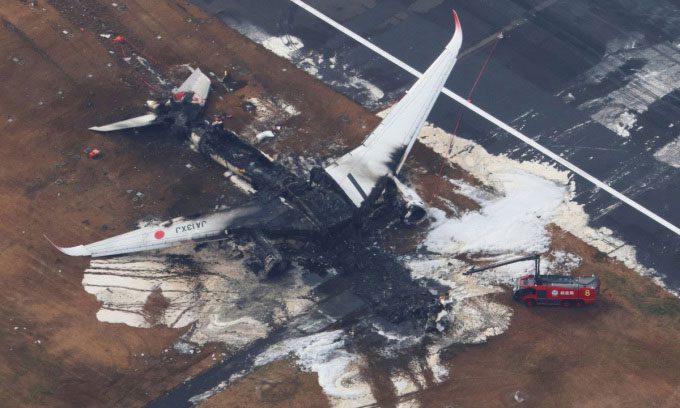A miraculous event occurred when an Airbus A350 encountered an accident, as all 367 passengers and 12 crew members were successfully evacuated before the flames engulfed the aircraft.
The moment the fire engulfed the A350 at Haneda Airport on January 2nd. (Video: Reuters)
The Airbus A350 carrying 379 people from Japan Airlines collided with a coast guard aircraft on the runway at Haneda Airport in Tokyo, Japan, on January 2nd. The collision caused both aircraft to catch fire, resulting in the death of five individuals aboard the coast guard plane.
Passengers on the Airbus A350 reported that an explosion occurred immediately upon landing. The entire cabin filled with smoke within minutes. The collision likely severed the aircraft’s fuel line, causing fuel to leak and ignite near the left engine. The flames then gradually spread to other areas of the aircraft. However, a miracle happened as all 367 passengers and 12 crew members aboard the Airbus A350 were successfully evacuated before the fire consumed the plane.
“The fuselage protected them from a truly horrifying fire – it did not burn up for a period of time and allowed people to escape. That is a positive sign,” safety consultant John Cox stated.
More than 54% of the A350 airframe is made from composite materials (carbon fiber composite), including the fuselage, wings, and other critical internal and external components. The primary purpose of these composite materials is to reduce weight while maintaining necessary strength, as well as to improve fuel efficiency. The aircraft’s structure and internal components are predominantly made from Carbon Fiber Reinforced Polymer (CFRP), a material composed of several components, including carbon fibers.
“From initial reports, there seems to be a significant amount of smoke in the cabin, and it is still unclear whether any of this smoke originated from burning composite materials,” said Todd Curtis, a former Boeing engineer and now a safety consultant.
Airbus adheres to strict regulations regarding fire, smoke, and toxicity for both internal and external materials. According to aviation standards, these materials are designed to be fire-resistant while providing the necessary durability.
“Fire, smoke, and toxicity (FST) requirements apply to every element inside the aircraft. Common composite materials used in both structure and cabin must also meet such smoke and toxicity requirements. In terms of fire resistance, CFRP can self-extinguish, and the thinner composite fuselage offers better fire resistance than equivalent metal skin,” Airbus explained.

The Airbus A350 burned through its fuselage and engines, leaving the wings intact. (Photo: Reuters).
The heating, degradation, burning, and physical changes of composite materials are precisely controlled during the material manufacturing process. Thermal degradation refers to the breakdown of molecules when materials become excessively hot. Aluminum begins to degrade at temperatures between 300 – 400 degrees Celsius and can melt at temperatures above 600 degrees Celsius. The combustion temperature of carbon fibers is between 400 – 1000 degrees Celsius, depending on the strength of the fiber.
It is important to note that the fiber matrix is crucial for the degradation process. Composite materials with a fiber matrix, such as CFRP, can withstand temperatures around 2000 degrees Celsius, significantly higher than that of individual carbon fibers. Furthermore, even when combustion has started, carbon composite materials will still maintain their structural integrity.
Composite materials used in aircraft enhance passenger survivability, according to reports from the European Committee. However, the properties of resin plastics can promote thermal degradation and combustion speed within composite materials.
In a composite fire, such as with the A350 aircraft, thermal degradation will vaporize the resin used to bond the carbon fibers within the matrix. As these vapors attempt to escape, pressure will build up within the composite material, increasing its volume. The material can expand more than double its volume, while porosity increases by 65% after burning. The combustion rate of composites depends on the vapor pressure generated within the material, and increasing thickness will extend the burn time.





















































